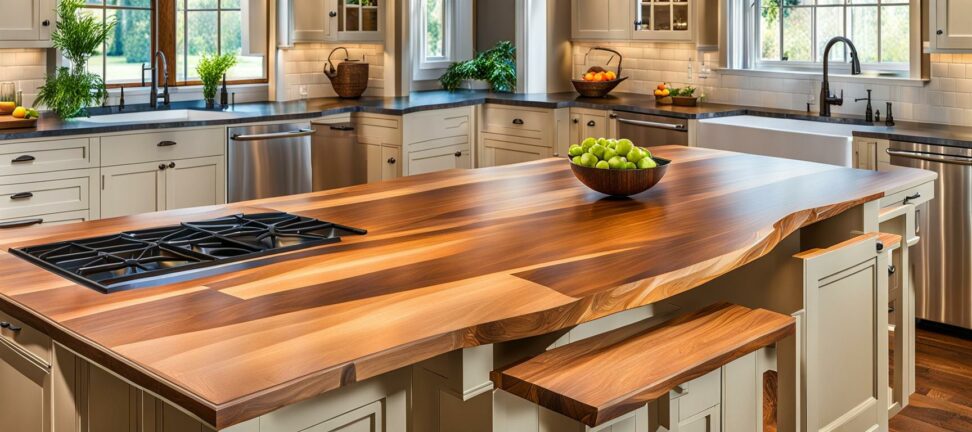Kitchen Island Drain Problems? Here's How to Diagnose and Fix Them
Is your kitchen island sink plagued by slow drains, gross odors, and standing water? These annoying issues can make meal prep a messy nightmare. But before calling an expensive plumber, try diagnosing and fixing the problem yourself.
With a few simple DIY techniques, you can get your island drain flowing freely again.
Common Drain Issues in Kitchen Islands
Several familiar but frustrating problems tend to affect kitchen island plumbing. Being able to identify the specific issue you're dealing with is the first step toward fixing it.
Clogged Drains
Just like the main kitchen sink, debris can gradually build up inside island drains and cause obstructions. Typical clogging culprits include food particles, grease, soap scum, and hair.

Signs of a clogged drain include water draining slower than usual and gurgling sounds as water goes down. Left unchecked, clogs can completely block water flow and lead to nasty sewer odors.
Luckily, there are several DIY methods to clear clogs, like using a plunger, baking soda and vinegar, or snaking the drain. Prevent future clogs by installing a sink strainer and using enzyme drain cleaners regularly.
Leaky Drain Pipes
Improperly installed plumbing under the island can also lead to annoying water leaks. Typical causes include loose slip joints, cracked drain pipes, and incorrect pipe slope.
Detect leaks by noticing visible water on the floor, musty smells from mold, or moisture under the island cabinetry. Fix minor leaks by tightening fittings, replacing gaskets, or adjusting pipe slopes for proper drainage.
Standing Water
Excess water pooling in the sink basin is another common island drain problem. Clogged drains can cause water to back up. An improperly installed p-trap that's too high or too low can also leave standing water.
Left stagnant, standing water emits unpleasant odors and allows germs to multiply. Fix it by clearing any clogs and adjusting the p-trap to the right height below the drain.
How to Diagnose Kitchen Island Drain Issues
Finding the root cause of the problem is key before attempting any repairs. Here are some easy ways to inspect your island drain.
Inspect Visible Pipes and Fittings
Remove any removable panels or grates and look for any obvious issues with the exposed plumbing. Check for cracks or corrosion damage, loose joints, and noticeable clogs.
Also check the slip joints and p-trap fittings for leakage, and make sure pipes have the proper downward slope for drainage.
Remove P-Trap and Check for Clogs
Unscrew the slip joints connecting the p-trap under the island sink. Inspect the curved section for any built-up gunk, food, hair, or grease that could be blocking water flow.
Removing the p-trap gives you visual access to the drain path to check for clogs. Reinstall it properly to maintain the water barrier against sewer gases.
Test Drain Flow Speed
Time how long it takes for water to fully drain out of the sink basin. Healthy drains should take no longer than about 60 seconds to empty. Comparing to your normal drainage speed helps identify new clogs.
Scope Camera Down the Drain
For precise diagnosis, use a small waterproof camera on a flexible cable to inspect inside the drain pipes. Scoping locates any obstructions like tree roots, grease, and soap buildup that simple drain cleaning can't always clear.
Fixing Common Island Drain Problems
Once you've identified the issue, it's time to tackle the repairs. Here are DIY tips for some typical island drain fixes.
Unclogging Drains
Try a plunger first for simple sink clogs. For deeper obstructions, use a drain auger or snake. Mix baking soda and vinegar and allow the fizzy reaction to break up gunk.
Severe clogs may require calling a professional plumber with high-pressure water jetting equipment.
Clearing Blocked P-Trap
Unscrew the p-trap section and remove any debris by hand. Scrub with a pipe brush. Reinstall the curved section sloped 1/4 inch per foot to maintain the proper water seal.
Fixing Leaky Pipes
Use a pipe wrench to tighten any loose slip joint connections. Replace old pipe gaskets and washers. Adjust connections for proper alignment and downward pitch.
Installing Proper Venting
Ensure any island plumbing has a vent to release sewer gases. Proper venting maintains air pressure so water drains smoothly. Without a vent, drainage will be sluggish.
Preventing Future Problems
With some simple maintenance and high-quality materials, you can avoid recurring drain headaches.
Regular Maintenance
Use a sink strainer to catch food debris. Boil water weekly to melt grease buildup. Add baking soda and vinegar monthly to keep drains clear.
Look for enzyme cleaners that actively dissolve organic gunk that causes clogs over time.
Quality Plumbing Materials
Invest in durable chrome or stainless steel for sink drain baskets. Use leak-proof piping like cast iron or copper when installing island drainage.
Proper Installation
Ensure drain pipes are sloped 1/4 inch per foot to prevent standing water. Install p-traps at the correct height. Vent pipes adequately so water and gases flow smoothly.
Taking time to properly install island plumbing prevents many avoidable problems down the road.
Dealing with a problematic kitchen island drain can be a messy nuisance, but fixing it yourself is usually pretty straightforward. Start by diagnosing the issue, then use the right DIY methods to get your drain flowing freely again.
With some simple maintenance habits and high-quality materials, you can prevent future clogs and leaks. But for any major repairs beyond DIY skills, don't hesitate to call a professional plumber.